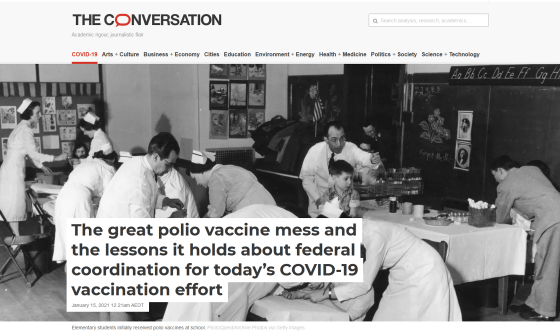What are the important past lessons for large-scale vaccination with the new corona vaccine?

Two vaccines, '
The great polio vaccine mess and the lessons it holds about federal coordination for today's COVID-19 vaccination effort
https://theconversation.com/the-great-polio-vaccine-mess-and-the-lessons-it-holds-about-federal-coordination-for-todays-covid-19-vaccination-effort-152806

◆ Problems related to large-scale polio vaccine inoculation
A viral poliomyelitis (polio) causes flu-like symptoms such as fever, headache, abdominal pain, and vomiting in some people, affecting the brain and spinal cord and causing paralysis in the lower limbs and respiratory muscles. In some cases, and in the worst case, death. Polio has been a threat to humankind for many years, but in the 1950s, American medical scientist Jonas Salk developed a polio vaccine using inactivated (dead) poliovirus.
After the U.S. government approved Mr. Soak's polio vaccine, the non-profit organization National Foundation for Infantile Paralysis (now March of Dimes) and a pharmaceutical company are worth $ 9 million (about 9 billion yen at the time of writing). In 1955, we started a program to vaccinate all first and second graders living in the United States. The goal is to vaccinate 30 million people in three months with polio, and Specter was also vaccinated in the spring of 1955.
However, two weeks after the first dose, public health officials announced that 'six children vaccinated with polio were infected with polio,' and some vaccines accidentally caused polio infection. It was discovered that it was. The mass vaccination program will be stopped less than a month after the first vaccination. Subsequent investigations revealed that Cutter Laboratories, California, was producing a vaccine with insufficient poliovirus inactivation, eventually causing paralysis in 200 children and 10 deaths. That is.
A series of events has reduced confidence in polio vaccines in the United States, and in a June 1955 (PDF file) survey , about half of parents said they would not let their children get polio vaccines in the future. This loss of confidence was a major problem, as polio vaccines require a total of three doses. In 1958, some pharmaceutical companies stopped producing vaccines because of 'people's indifference'. Until the introduction of the new polio vaccine developed by Albert Sabin in 1960, public trust remained. Specter said he didn't return.

◆ Lessons learned from the case of polio vaccine
'The polio vaccine story provides some lessons for the distribution of the new coronavirus infection (COVID-19) vaccine,' said Specter, citing the following lessons:
· Life-saving medical products need federal coordination
Polio vaccine distribution in 1955 was done through non-profit organizations, and the federal government avoided active involvement in vaccination. Oveta Culp Hobby , who was the Secretary of Health, Education and Welfare at the time, was concerned about 'government-controlled medicine' and thought that vaccination should be left to the private sector. As a result, safety checks were left to private laboratories that manufacture vaccines, and the federal government was unaware of the problems with Cutter's vaccines, Specter said.
・ Public trust is important in the vaccine distribution process
When polio vaccination began in 1955, people had no fear of the vaccine other than injection puncture wounds. However, after the vaccinated child developed polio, poor explanations and delays in response by government officials disrupted the entire production and distribution process, reducing public confidence in the vaccine. Decreased confidence in the vaccine can be a major problem even with the new coronavirus vaccine, which requires two doses to be fully effective, so Specter said the federal government would build public confidence while working. He argued that it was important to implement a traditional vaccine distribution program.

Although vaccination with the new coronavirus is undoubtedly a major step forward, the advent of the vaccine does not completely eliminate the threat of COVID-19. Stefan Banseru CEO of Moderna is, 'No be the new coronavirus is no longer' has said , claiming that there is a need to address gazing at the ongoing new coronavirus in the future. Others say that not only vaccination but also low-tech strategies such as quarantine and quarantine of infected people, tracking of infected people, and communication between public health authorities and the public are important to contain the new coronavirus.
Related Posts:
in Science, Posted by log1h_ik







